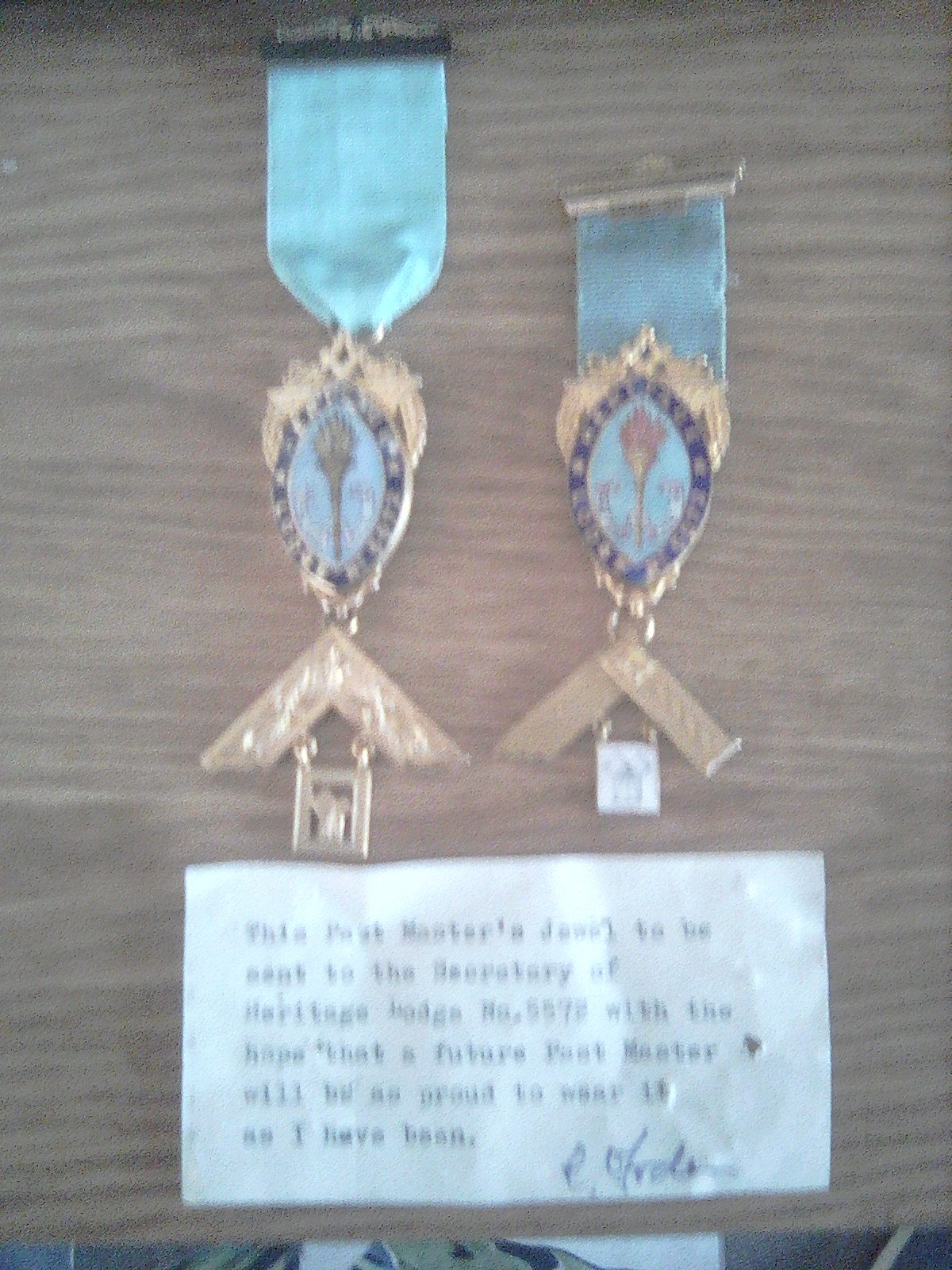It is traditional in Heritage Lodge to present the outgoing Master with a ‘Past Master’s Jewel’ and we are privileged to own three such jewels which are ceramic and decorated with the ‘blazon torch’ emblem of the Lodge. (See below for images)
These Jewels were made from original ‘founder’s Jewels’ and are engravened with the names of those worthy and distinguished brethren to whom they were first presented.
As with most things associated with Freemasonry these jewels have other symbolic meaning and in the following I have set out a short explanation of their symbolic significance for those in the Lodge who may not have appreciated what the Jewel represents.
In simple terms the jewel represents the 47th Problem of Euclid and is meant to represent the progress made in Freemasonry by the recipient having served the Lodge as Master.
Euclid was a celebrated mathematician who lived and taught in Alexandria between 260 – 320 b.c. and who wrote a set of thirteen books which were called ‘Elements’.
These thirteen books contained 465 problems, the 47th of which was known as ‘The Pythagorean Theorem’.
I remember as a schoolboy being taught ‘Pythagoras’s Theory’ as:
the square of the hypotenuse equals the sum of the square of the other two sides’. (A2 + B2 = C2).
In the 3rd Degree lecture we learn that the wise Philosopher (Pythagoras) enriched his mind in general knowledge of things and more especially in Geometry or Masonry.
He drew out many problems and theorems and when he solved these problems he was said to have exclaimed ‘Eureka ‘which in Greek means ‘I have found it’ and apon the discovery is said to have sacrificed a Hecatomb. (In ancient Rome and Greece, a sacrifice to the Gods - often of a 100 oxen).
So that’s where the goat came from!!??
In Masonic terms this generally teaches Masons to be lovers of the ‘Arts and Sciences’.
The rule established here was however actually discovered by the Egyptians who used the same principle to remeasure their fields after the annual flooding of the Nile washed out their boundary markers. Hence Pythagoras is more likely here referred to as the person who proved that the process worked.
Pythagoras established a society with philosophical, religious and political aims which was shrouded in secrecy which believed that only by truly understanding the Universe could one achieve salvation of the soul as Divinity created all things and by studying it over several lifetimes would bring one closer to the same Divinity. All these beliefs were based on ‘measurable things’ (i.e. numbers and objects).
This doctrine, incorporated in to Freemasonry, sets it opposite to the Church which emphasizes faith over reason.
It is interesting however to note that In the ‘Book of Wisdom - 11.20’ we read:
Even apart from these, men could fall at a single breath when pursued by Justice and scattered by the breath of thy power. But thou has arranged all things by measure and number and weight.
Hence we find that the very ‘measurement of things’ that the Church objects to is actually mentioned in Scriptures.
You will no doubt recall in Freemasonry we are taught to ‘measure our actions by the rule of rectitude’ – reference again to the measurement of things.
Using The Pythagoras Theorem in architecture we find the proposition well applied by builders in ‘Squaring the building’ as the theorem states that 3 squared + 4 squared = 5 Squared (a 3/4/5 triangle).
Engineers also use the 47th Problem to get two shafts to align through a mountain, the navigator to determine his latitude and longitude and the astronomer the distance of the sun, the moon and the planets which in turn fixes the duration and times of the seasons of the year.
When applied to a circle the 47th Problem exposes how the ancient Egyptians set out the Great Pyramids and the mathematical relationship with the Cubit being the measurement of length of the ancient world.
In conclusion then the 47th Problem of Euclid clearly helps us look at the Universe through a ‘measurable’ system which is understandable and is well applied by Freemasons as a guide to their actions.
The Past Master’s jewel is therefore a reminder of these principles being a square as the base dedicated to the 47th Problem which as the Master serves his position he becomes more complete and thereby the jewel represents his progress in both in his life and in Freemasonry as he leaves office.
I trust therefore to those reading this of interest, to those who have already been presented with a Past Master’s jewel and those yet to come you are now more enlightened as to the significance of its origin?
Tony Saunders
References:
H.Meij – WM Harmony Lodge no. 18
Circumambulation and Euclid’s 47th Proposition – by Reid McInvale
Encyclopaedia of Freemasonry – by Albert Mackey
Freemasonry, A journey through ritual and symbol – by W.Kirk
Master Mason – by Carl Claudy

